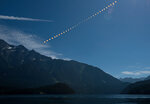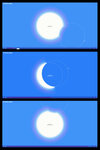As the moon gradually moves into alignment between the Earth and the sun on April 8, you will feel a shift take place.
The daylight will gradually dim, reminiscent of a sudden summer storm or an …
This item is available in full to subscribers.
Please log in to continue |



As the moon gradually moves into alignment between the Earth and the sun on April 8, you will feel a shift take place.
The daylight will gradually dim, reminiscent of a sudden summer storm or an abnormally fast sunset. A slight drop in temperature will be noticeable in the air. Birds will interpret the dimming light as a signal of impending nightfall and cease their songs. Crickets may begin to chirp. Honeybees may seem confused. Leaves on plants may droop into their night positions. Flowers may close their petals.
This is the phenomenon of an eclipse unfolding.
This year, alongside Earth Day, National Poetry Month and National Autism Awareness Month, April holds a special celestial treat: the third and final Super New Moon of 2024 and, most notably, a total solar eclipse that will be partially visible in Baldwin County.
When a New Moon occurs at its closest point to Earth in its orbit, it is referred to as a Super New Moon. This series of Super New Moons began on Feb. 9 and continued on March 10. Unlike typical New Moons, Super New Moons are often not observable from Earth due to their alignment with the sun, yet they offer enthusiasts ample opportunities for stargazing under darkened skies.
However, the upcoming Super New Moon on April 8 will captivate attention nationwide for a unique reason: it will coincide with a total solar eclipse. During this event, the moon will pass directly between the Earth and the sun, casting its shadow upon the Earth's surface.
Several times a year, a celestial event occurs when the Earth, moon and sun align perfectly, resulting in the captivating phenomenon known as an eclipse. This occurrence is due to the moon's orbit around Earth, which is tilted compared to Earth's orbit around the sun. This tilt causes eclipses to happen sporadically rather than on a monthly basis.
There are two main types of eclipses: lunar and solar. A lunar eclipse occurs when Earth's shadow passes over the moon, while a solar eclipse occurs when the moon blocks the sun from our perspective.
Solar eclipses exclusively occur during the new moon phase when the moon is positioned between Earth and the sun. During a solar eclipse, the moon's shadow falls on Earth, partially or completely obscuring our view of the sun. Despite solar eclipses happening as frequently as lunar eclipses, they are much less common to witness due to their limited visibility from specific regions on Earth.
A total solar eclipse occurs when the moon aligns perfectly between the Earth and the sun, obscuring the latter completely. Those fortunate enough to find themselves within the path of totality will witness a dramatic darkening of the sky, similar to twilight, and may catch a glimpse of the sun's elusive corona, or outer atmosphere, which is usually obscured by the brightness of the sun.
This year, the entirety of the lower 48 contiguous U.S. states will be able to see at least a partial eclipse, with 15 states in the path of totality where viewing the total solar will be possible. Even more fun is that according to scientists the sun is nearing its peak of solar maximum meaning there may be more activity to look at compared to the 2017 eclipse.
In addition to these phenomena, the sun, like the moon, affects Earth's tides. Solar tides, although smaller than lunar tides, contribute to high and low tides during alignments like new or full moons. A solar eclipse occurring during a new moon phase coincides with spring tides, resulting in exceptionally high high-tides and low low-tides along the eclipse path.
To get the full experience, you'll need to be situated within the path of totality, a narrow track where the moon's shadow will trace across Earth.
For residents of Baldwin County, although our area falls outside the path of totality, a notable reduction in sunlight is expected during the peak hours of the eclipse, between 1 and 2 p.m. To see an animation of the eclipse in our area (or any area you may be traveling to) visit www.timeanddate.com. Our region lies within the path of 75% totality, with Mobile and Pensacola boasting a 40-60% likelihood of visibility according to the U.S. Climate Normals-based interactive map on the NOAA website for weather viewability.
However, the spectacle is subject to favorable weather conditions. According to the NWS Climate Prediction Center, Baldwin County has a 40-60% above normal probability (percent chance) of precipitation for the month of April.
To aid eclipse enthusiasts, NOAA (National Oceanic and Atmospheric Administration) National Centers for Environmental Information (NCEI) has collaborated with the North Carolina Institute for Climate Studies to create an interactive map. This map offers insights into factors such as heat index, temperature and wind chill, aiding viewers in choosing optimal viewing locations.
To view the map, visit www.ncei.noaa.gov/news/take-your-head-out-clouds-view-2024-total-solar-eclipse.
This tool provides historical averages rather than definitive predictions. Local weather forecasts and updates from NOAA and the NWS (National Weather Service) are essential for accurate planning.
Of course, in the event of rain or if you are traveling and not in the path of the eclipse, there's still opportunities to engage with this celestial event.
The National Science Foundation (NSF) invites the public to join their live YouTube event on April 8 starting at 12:55 p.m. CDT. The broadcast will feature NSF scientists discussing the solar eclipse and solar science. Participants will hear from real scientists and explore cutting-edge facilities like the NSF Daniel K. Inouye Solar Telescope. The livestream, provided free of charge by the NSF, serves as a valuable resource for teachers looking to incorporate scientific excitement into their classrooms.
For more information, visit new.nsf.gov/events/solar-eclipse-2024.
Additionally, NASA will be conducting a live broadcast from noon to 3 p.m. CDT on the day of the eclipse. Visit science.nasa.gov/eclipses/future-eclipses/eclipse-2024/live/ to learn more.
Looking directly at the sun, except during the brief total phase in the totality zone (which, again, will not happen in Baldwin County), can pose a severe risk of eye injury.
Regular sunglasses, no matter how dark, are inadequate for sun viewing. Prior to observing the eclipse, ensure your eyes are covered with eclipse glasses or a solar viewer.
Viewing the sun through a camera lens, binoculars or telescope without a solar filter will cause immediate eye injury. Avoid using optical devices without proper filtration while wearing eclipse glasses or handheld solar viewers. Supervision of children using solar filters or glasses is necessary.
NASA advises against using fake or homemade eclipse glasses. Beware of claims of NASA approval, as NASA does not endorse products and does not provide approvals. Proper solar glasses must block UV light, not just be dark. Check reputable sources for approved suppliers of eclipse glasses and viewers and make sure they are rated with the ISO 12312-2 international safety standard.
"The only thing that you should see is the sun through them," said Shannon Schmoll, director of the Abrams Planetarium at Michigan State University, during a media brief.
It is essential to inspect solar glasses or filters before use and discard them if damaged. Always follow instructions provided with eye protection. After viewing the eclipse, turn away and remove eye protection without looking at the sun.
For more information on eclipse and eye safety, visit the American Astronomical Society's website at eclipse.aas.org/safety.
For a simple and fun DIY solution, create your own pinhole projector to view the eclipse.
Though the moon will block the sun for a period of time, those interested in outside activities during the eclipse should remember sunscreen. Also, keep water on hand to keep hydrated.
The spring tides mentioned before could also pose a risk so make sure to keep safe if your plans include the beach.
If you plan on traveling to witness the eclipse, keep in mind that as excitement for the eclipse grows, you should plan for heavy traffic and crowded venues. Booking accommodations in advance and ensuring provisions for food, water and restrooms are essential especially on lengthy road trips.
"I ended up stuck in traffic for about 13.5 hours during the 2017 eclipse, so be prepared for that," Schmoll said.
The rarity of total solar eclipses highlights their significance. Following April's event, the next total solar eclipse in the United States won't occur until March 2033 and will only be viewable in Alaska. After that, the next total solar eclipse won't occur until August 2044 and will only be viewable in Montana and North Dakota.
The next opportunity for the majority of Americans to witness a solar eclipse in the contiguous United States won't be until August 2045 (over 20 years) when the eclipse will traverse the contiguous U.S. from Florida to California.
Another reason you shouldn't miss the eclipse? The awe factor.
Paul Piff, an associate professor of psychological science at the University of California, Irvine, defined 'awe' as "an experience of such perceptual vastness, one has to reconfigure their mental models of the world to accommodate it."
According to Piff, those who experience those moments of awe have reported improved health outcomes, better wellbeing and insignificant or humbled views of themselves.
"And we find, somewhat interestingly, awe seems to trigger more kind, compassionate and empathic behavior among people," Piff said during the media brief.
Enthusiasts are encouraged to seize this moment and experience the celestial marvel firsthand. Prepare for the event by securing proper eye wear now and planning your viewing location using NASA's interactive map as well as NWS weather forecasts. As April approaches, the countdown to this decade's grandest solar event has begun.
Planning on taking a trip to witness the eclipse and looking for areas with eclipse totality?
Gulf Coast Media has compiled a list of the nearest cities along the totality line of the eclipse from Foley, serving as the central point of reference within the county.
Remember to check weather forecasts and conditions in advance of your trip. Also, if you are traveling, look for eclipse specific